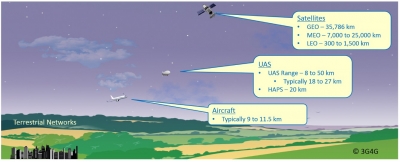Zahid Ghadialy, Principal Analyst & Consultant, 3G4G and Senior Director, Strategic Marketing, Parallel Wireless
Published: 5 Dec 2019

CTN Issue: December 2019

A note from the editor:
This article is a sequel to preceding articles on a range of topics related to satellite communications or flying platforms-based networks that CTN published during past few months. In this article, Zahid Ghadialy presents a consolidated framework to integrate spaceborne and airborne satellite networks into non-terrestrial networks to complement the existing terrestrial networks and discusses some potential architecture, use cases, open issues and standardization efforts as carried out by 3GPP working group.
To summarize the role of non-terrestrial networks for future global and ubiquitous connectivity, here are some use cases, not limited to:
- Provision of backhaul/fronthaul for macro cell/small cell networks, e.g., wireless fronthaul for hard to read small cells or wireless backhaul for resource limited infrastructure environment in rural areas.
- Provision of flying base stations and access network, e.g., flying balloons or spaceborne/airborne networks for disaster communications or coverage and capacity expansion for temporary events.
- Provision of autonomous coverage hole detection, e.g., flying platforms can detect the coverage holes or poor signal efficiently and autonomously than any drive test or using network data.
Enjoy and as usual we welcome your feedback and suggestion.
Editor

The Role of Non-Terrestrial Networks (NTN) in Future 5G Networks

Zahid Ghadialy
Principal Analyst & Consultant, 3G4G and Senior Director, Strategic Marketing
Introduction
Satellite has long been used in conjunction with mobile networks although it has been limited to supplying backhaul for the access networks typically in rural and remote areas, wherein other forms of backhaul are often difficult to provide. The satellite industry on the other hand has long desired to use the satellites not just for backhaul but also for access networks. Based on this expression of interest by the satellite industry, the initial 3GPP Release-15 version of [1] added the initial requirement that the 5G system will be able to provide services using satellite access.
A study was carried out by 3GPP as a part of 3GPP Release-16 and the results of the study on using satellite access in 5G networks have been documented in [2]. The document details the use cases, pre and post conditions, service flows, potential impacts / interactions with existing services / features and potential requirements based on the use case. The results from this technical report (TR) were then reflected in 3GPP Release-16 version of the technical specification (TS) [1]. The document details the need for the 5G system to support service continuity between terrestrial 5G access and satellite based 5G access networks, owned by either the same operator or by an agreement between operators.
While satellite is a type of non-terrestrial access network, it was felt that there are other types of non-terrestrial networks that have an overlap with satellite use cases, requirements, etc. As a result, the scope was expanded to cover different kinds of spaceborne and airborne vehicles into a single umbrella of Non-Terrestrial Networks or NTN. [3] provides a characterization of satellite access as a result of a 3GPP TSG RAN study.
Definition of NTN

3GPP defines NTN as networks, or segments of networks, using an airborne or spaceborne vehicle for transmission [4]:
- Spaceborne vehicles: Satellites (including Low Earth Orbiting (LEO) satellites, Medium Earth Orbiting (MEO) satellites, Geostationary Earth Orbiting (GEO) satellites as well as Highly Elliptical Orbiting (HEO) satellites).
- Airborne vehicles: High Altitude Platforms (HAPs) encompassing Unmanned Aircraft Systems (UAS) including Lighter than Air UAS (LTA), Heavier than Air UAS (HTA), all operating in altitudes typically between 8 and 50 km, quasi-stationary.
These NTN platforms are further characterized as [5]:
| Platforms | Altitude range | Orbit | Typical beam footprint size |
| Low-Earth Orbit (LEO) satellite | 300 – 1500 km | Circular around the earth | 100 – 500 km |
| Medium-Earth Orbit (MEO) satellite | 7000 – 25000 km | Circular around the earth | 100 – 500 km |
| Geostationary Earth Orbit (GEO) satellite | 35 786 km | notional station keeping position fixed in terms of elevation/azimuth with respect to a given earth point | 200 – 1000 km |
| UAS platform (including HAPS) | 8 – 50 km (20 km for HAPS) | notional station keeping position fixed in terms of elevation/azimuth with respect to a given earth point | 5 - 200 km |
| High Elliptical Orbit (HEO) satellite | 400 – 50000 km | Elliptical around the earth | 200 – 1000 km |
Use Cases
NTN are expected to play a big role in both 5G enhanced mobile broadband (eMBB) as well as massive machine type communications (mMTC). At a high level, the following use cases can be foreseen:
eMBB:
- Rural fixed broadband at home and enterprise
- Rural mobile broadband
- Mobile broadband to passengers in vehicles, vessels or aircrafts
- Enhanced data rates in conjunction with terrestrial networks using technologies like Access Traffic Steering, Switching and Splitting (ATSSS)
- Network resilience for public safety or other critical links
mMTC:
- Rural and remote IoT that can be connected via IoT gateways, backhauled via NTN
- Freight tracking across countries, regions and oceans
Architecture
[5] includes the description of NG-RAN reference architectures supporting various NTN scenarios. The three main architectures under consideration are:
- Transparent-satellite based NG-RAN architecture,
- Regenerative-satellite based NG-RAN architecture with gNB on board, and
- Regenerative-satellite based NG-RAN architecture with gNB-DU on board.
Transparent-satellite Based NG-RAN Architecture

Picture source: [5] - Networking-RAN architecture with transparent satellite.
In this case the Satellite/NTN acts like a repeater, repeating the signal from gNodeB, located on the ground.
In this case, the Satellite/NTN would implement the frequency conversion and RF amplifier, acting as an analogue RF repeater, leaving all the intelligence in gNodeB on the ground. An advanced implementation can also make use of multiple gNodeBs connecting to a single Satellite/NTN. As the logic is in gNodeB on the ground, it can be upgraded to newer software and new/updated features without issues.
Regenerative-satellite Based NG-RAN Architecture with gNB on Board

Picture source: [5] - Regenerative satellite without ISL, gNB processed payload
In this case, the whole gNodeB is located on the Satellite/NTN. The Satellite Radio Interface (SRI) carries the NG interface. The picture above is shown without any Inter-Satellite Link (ISL) to other satellites, but this architecture would naturally enable communication between them over the Xn interface.
In fact, the architecture could be extended to have terrestrial and non-terrestrial gNodeBs talking to each other. While this architecture can introduce significant deployment challenges, it can also introduce freedom for various NTNs to be independently connected to each other. It can work nicely with LEO satellites.
Regenerative-satellite Based NG-RAN Architecture with gNB-DU on Bboard

Picture source: [5] - NG-RAN with a regenerative satellite based on gNB-DU
This architecture takes the advantage NG-RAN logical architecture with CU/DU split as described in [6]. The Central Unit (CU) is located on the ground while the Distributed Unit (DU) is onboard the Satellite/NTN. This architecture also allows DUs on board different Satellites/NTN to be connected to the same CU on the ground.
As the DUs on Satellite/NTN needs connection to CU on ground, this architecture would not work very well for LEO satellites. On the other hand, the flexibility to connect multiple DUs to a single CU means that the processing can be distributed and connectivity to 5GC could be simplified.
3GPP Timeline
Due to tight deadlines for 3GPP Release 16, priority is being given to study of the set of necessary features/adaptations enabling the operation of NR protocol in NTN for satellite access. UAS (including HAPS) based access could be considered as a special case of non-terrestrial access with lower delay/Doppler value and variation rate [4].
Targeted usage-scenarios with satellite access are pedestrian, stationary in building, on board vehicle, high speed train or airplanes. Stationary in building, on board vehicle, high speed train or airplanes usage-scenarios may require a relay UE. The priority of the Rel-16 study will be on pedestrian and on-board vehicle usage-scenarios.
The possible reference scenarios and architecture options for NTN will be identified and described. However, the scope of the release 16 study item will be limited to key issues and solutions associated with transparent GEO satellite and LEO based non-terrestrial access network (moving beam on earth). Advanced features like integrated access and backhaul (IAB) as well as the combined operation of GEO / LEO networks for idle mode are not being considered during release 16.
Conclusions
For the first time, 3GPP standards are looking at Satellites and NTN in detail for complementing terrestrial 5G. With many different LEO megaconstellations planned in the coming years, having a standard in place can provide a means to have standards based ubiquitous connectivity. This kind of continuity could be very useful for IoT devices like tracking of containers, etc. Other types of devices like smartphones or connected cars would most likely be able to take advantage of NTN where no terrestrial coverage is available. 5G has a potential to enable truly ubiquitous connectivity.
References
- 3GPP TS 22.261: Service requirements for the 5G system; Stage 1
- 3GPP TR 22.822: Study on using Satellite Access in 5G; Stage 1
- 3GPP TR 38.811: Study on New Radio (NR) to support non terrestrial networks
- 3GPP TSG RAN meeting #83 RP-190710: Revised SID for Study on solutions for NR to support non-terrestrial networks (NTN)
- 3GPP TR 38.821: Solutions for NR to support non-terrestrial networks (NTN)
- 3GPP TS 38.401: NG-RAN; Architecture description
Acknowledgements: The author would like to thank Toon Norp, Senior Business Consultant at TNO & 3GPP SA1 chairman at KPN for his helpful advice and guidance.
Statements and opinions given in a work published by the IEEE or the IEEE Communications Society are the expressions of the author(s). Responsibility for the content of published articles rests upon the authors(s), not IEEE nor the IEEE Communications Society.


